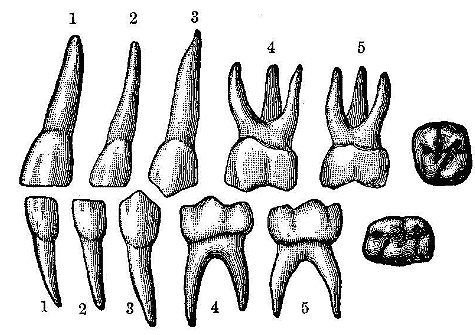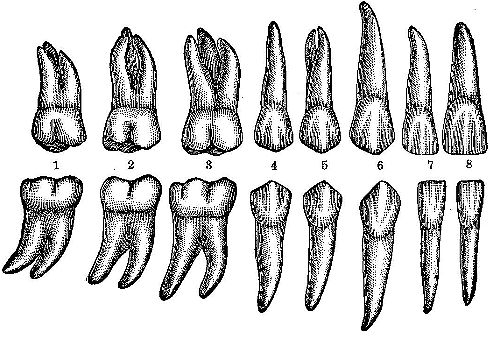Classification And Descriptive Anatomy Of The Teeth.

Nearly all of the mammalia possess a more or less complicated dental system. These organs are applied to various purposes, mainly, however, to that of procuring food by seizing and killing living prey, or gathering and biting off portions of vegetable material, and more indirectly in tearing or cutting through the hard protective coverings of food substances, such as the husks and shells of nuts, or in grinding, crushing, or otherwise mechanically dividing the solid materials before swallowing, so as to prepare them for digestion in the stomach.
In many animals certain teeth are excessively developed, and are used as weapons of offense and defense; in others the presence or excessive development of certain teeth mark the male sex.
Man is an omnivorous animal (the term omnivorous comes from the Latin Omnis, all, and voro, I eat), and, as the term implies, eats all kinds of food. He has been endowed by nature with organs of mastication suited to the requirements of cutting, tearing, and grinding these various forms of food. Man's teeth, therefore, represent in, part those of the carnivora, or fish-eating animals, and those of the herbivora, or vegetable eating animals; in other words, certain of his dental organs are representative of both of these types of animals. The incisors and molars are typical of the herbivora, and are suited to cutting and grinding vegetable fiber and grains, while the cuspids and bicuspids represent the teeth of the carnivora, and are adapted to seizing, .tearing, and cutting animal food.
Number And Classification Of The Teeth
Man, like many others of the mammalia, is endowed with two distinct sets of dental organs, one designed to serve the purposes of the economy during infancy and early childhood, the deciduous, temporary, or milk teeth; and the other a larger, stronger, and more numerous set, which replaces the deciduous teeth, and is designed to serve the purposes of the economy from childhood to old age; these are designated as the permanent teeth.
The deciduous teeth are twenty in number, ten in each jaw.
Decidious teeth of the left side. 1 and 2, incisors ; 3, cuspidate ; 4 and 5, molars.

The permanent teeth of man are thirty-two in number, sixteen in each jaw. Permanent teeth of the right side. (Gray.) 1, third molars; 2, second molars; 3, first molars; 4, second bicllspidati; 5, first bicuspidati; 6, cuspidati; 7, lateral incisors; 8, central incisors.

The Dentist's Diplomat
This is an instructive summary of the qualifications and the duties of the present day Dental Assistant -- The Diplomat standing between the dentist and lost income. | read more |
Press Releases
- Learn How to Smile Again
- For immediate release
- 1st Anniversary Exhibition a Gift for FindaDentist.com
- Website Brings Patients and Doctors Together
- Dental show #4 proved to be FindaDentist.com's most successful show yet
- The Windy City Welcomes FindaDentist.com With Open Arms
- FindaDentist.com Goes Home for Show #2
- New Partnership for FindaDentist.com Encourages Brite Future for Dentists and Patients
- First Show Experience a Success for FindaDentist.com
- Internet Dental Partnership Promises Ease for Patients and Powerhouse Exposure For Dentists
- Website Launches To Ease Trouble of Finding New Dentist
- "Dental Phobia" - Are you afraid of the dentist
- Dental Office Design
- History of Teeth whitening and teeth bleaching
- Dental Code of Ethics
- Classification And Descriptive Anatomy Of The Teeth.


